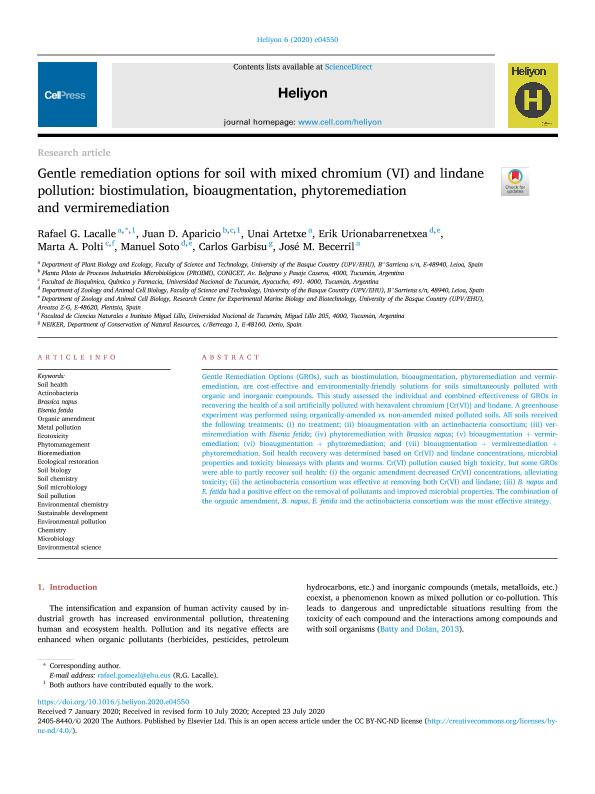Mostrar el registro sencillo del ítem
dc.contributor.author
Lacalle, Rafael G.
dc.contributor.author
Aparicio, Juan Daniel

dc.contributor.author
Artetxe, Unai
dc.contributor.author
Urionabarrenetxea, Erik
dc.contributor.author
Polti, Marta Alejandra

dc.contributor.author
Soto, Manuel
dc.contributor.author
Garbisu, Carlos
dc.contributor.author
Becerril, José M.
dc.date.available
2020-11-20T12:09:09Z
dc.date.issued
2020-08
dc.identifier.citation
Lacalle, Rafael G.; Aparicio, Juan Daniel; Artetxe, Unai; Urionabarrenetxea, Erik; Polti, Marta Alejandra; et al.; Gentle remediation options for soil with mixed chromium (VI) and lindane pollution: biostimulation, bioaugmentation, phytoremediation and vermiremediation; Elsevier Ltd; Heliyon; 6; 8; 8-2020
dc.identifier.issn
2405-8440
dc.identifier.uri
http://hdl.handle.net/11336/118685
dc.description.abstract
Gentle Remediation Options (GROs), such as biostimulation, bioaugmentation, phytoremediation and vermiremediation, are cost-effective and environmentally-friendly solutions for soils simultaneously polluted with organic and inorganic compounds. This study assessed the individual and combined effectiveness of GROs in recovering the health of a soil artificially polluted with hexavalent chromium [Cr(VI)] and lindane. A greenhouse experiment was performed using organically-amended vs. non-amended mixed polluted soils. All soils received the following treatments: (i) no treatment; (ii) bioaugmentation with an actinobacteria consortium; (iii) vermiremediation with Eisenia fetida; (iv) phytoremediation with Brassica napus; (v) bioaugmentation + vermiremediation; (vi) bioaugmentation + phytoremediation; and (vii) bioaugmentation + vermiremediation + phytoremediation. Soil health recovery was determined based on Cr(VI) and lindane concentrations, microbial properties and toxicity bioassays with plants and worms. Cr(VI) pollution caused high toxicity, but some GROs were able to partly recover soil health: (i) the organic amendment decreased Cr(VI) concentrations, alleviating toxicity; (ii) the actinobacteria consortium was effective at removing both Cr(VI) and lindane; (iii) B. napus and E. fetida had a positive effect on the removal of pollutants and improved microbial properties. The combination of the organic amendment, B. napus, E. fetida and the actinobacteria consortium was the most effective strategy.
dc.format
application/pdf
dc.language.iso
eng
dc.publisher
Elsevier Ltd
dc.rights
info:eu-repo/semantics/openAccess
dc.rights.uri
https://creativecommons.org/licenses/by-nc-sa/2.5/ar/
dc.subject
ACTINOBACTERIA
dc.subject
BIOREMEDIATION
dc.subject
BRASSICA NAPUS
dc.subject
CHEMISTRY
dc.subject
ECOLOGICAL RESTORATION
dc.subject
ECOTOXICITY
dc.subject
EISENIA FETIDA
dc.subject
ENVIRONMENTAL CHEMISTRY
dc.subject
ENVIRONMENTAL POLLUTION
dc.subject
ENVIRONMENTAL SCIENCE
dc.subject
METAL POLLUTION
dc.subject
MICROBIOLOGY
dc.subject
ORGANIC AMENDMENT
dc.subject
PHYTOMANAGEMENT
dc.subject
SOIL BIOLOGY
dc.subject
SOIL CHEMISTRY
dc.subject
SOIL HEALTH
dc.subject
SOIL MICROBIOLOGY
dc.subject
SOIL POLLUTION
dc.subject
SUSTAINABLE DEVELOPMENT
dc.subject.classification
Bioremediación, Diagnóstico Biotecnológico en Gestión Medioambiental

dc.subject.classification
Biotecnología del Medio Ambiente

dc.subject.classification
INGENIERÍAS Y TECNOLOGÍAS

dc.title
Gentle remediation options for soil with mixed chromium (VI) and lindane pollution: biostimulation, bioaugmentation, phytoremediation and vermiremediation
dc.type
info:eu-repo/semantics/article
dc.type
info:ar-repo/semantics/artículo
dc.type
info:eu-repo/semantics/publishedVersion
dc.date.updated
2020-09-25T19:00:43Z
dc.journal.volume
6
dc.journal.number
8
dc.journal.pais
Estados Unidos

dc.description.fil
Fil: Lacalle, Rafael G.. Universidad del País Vasco; España
dc.description.fil
Fil: Aparicio, Juan Daniel. Universidad Nacional de Tucumán; Argentina. Consejo Nacional de Investigaciones Científicas y Técnicas. Centro Científico Tecnológico Conicet - Tucumán. Planta Piloto de Procesos Industriales Microbiológicos; Argentina
dc.description.fil
Fil: Artetxe, Unai. Universidad del País Vasco; España
dc.description.fil
Fil: Urionabarrenetxea, Erik. Universidad del País Vasco; España
dc.description.fil
Fil: Polti, Marta Alejandra. Universidad Nacional de Tucumán; Argentina. Consejo Nacional de Investigaciones Científicas y Técnicas. Centro Científico Tecnológico Conicet - Tucumán. Planta Piloto de Procesos Industriales Microbiológicos; Argentina
dc.description.fil
Fil: Soto, Manuel. Universidad del País Vasco; España
dc.description.fil
Fil: Garbisu, Carlos. Centro de Investigación. Neiker - Tecnalia; España
dc.description.fil
Fil: Becerril, José M.. Universidad del País Vasco; España
dc.journal.title
Heliyon
dc.relation.alternativeid
info:eu-repo/semantics/altIdentifier/doi/https://dx.doi.org/10.1016/j.heliyon.2020.e04550
dc.relation.alternativeid
info:eu-repo/semantics/altIdentifier/url/https://www.cell.com/heliyon/fulltext/S2405-8440(20)31394-3?_returnURL=https%3A%2F%2Flinkinghub.elsevier.com%2Fretrieve%2Fpii%2FS2405844020313943%3Fshowall%3Dtrue
Archivos asociados
